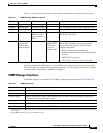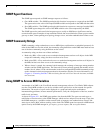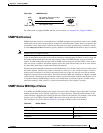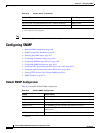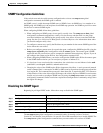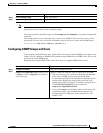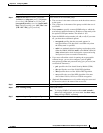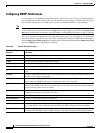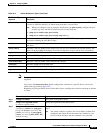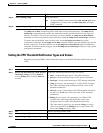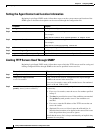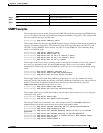
30-11
Catalyst 2960 and 2960-S Switch Software Configuration Guide
OL-8603-09
Chapter 30 Configuring SNMP
Configuring SNMP
Step 4
snmp-server user username groupname
{remote host [udp-port port]} {v1 [access
access-list] | v2c [access access-list] | v3
[encrypted] [access access-list] [auth {md5 |
sha} auth-password]} [priv {des | 3des | aes
{128 | 192 | 256}} priv-password]
Add a new user for an SNMP group.
• The username is the name of the user on the host that connects
to the agent.
• The groupname is the name of the group to which the user is
associated.
• Enter remote to specify a remote SNMP entity to which the
user belongs and the hostname or IP address of that entity with
the optional UDP port number. The default is 162.
• Enter the SNMP version number (v1, v2c, or v3). If you enter
v3, you have these additional options:
–
encrypted specifies that the password appears in
encrypted format. This keyword is available only when
the v3 keyword is specified.
–
auth is an authentication level setting session that can be
either the HMAC-MD5-96 (md5) or the HMAC-SHA-96
(sha) authentication level and requires a password string
auth-password (not to exceed 64 characters).
• If you enter v3 and the switch is running the cryptographic
software image, you can also configure a private (priv)
encryption algorithm and password string priv-password (not
to exceed 64 characters).
–
priv specifies the User-based Security Model (USM).
–
des specifies the use of the 56-bit DES algorithm.
–
3des specifies the use of the 168-bit DES algorithm.
–
aes specifies the use of the DES algorithm. You must
select either 128-bit, 192-bit, or 256-bit encryption.
• (Optional) Enter access access-list with a string (not to exceed
64 characters) that is the name of the access list.
Step 5
end Return to privileged EXEC mode.
Step 6
show running-config Verify your entries.
Note To display SNMPv3 information about auth | noauth |
priv mode configuration, you must enter the show snmp
user privileged EXEC command.
Step 7
copy running-config startup-config (Optional) Save your entries in the configuration file.
Command Purpose



